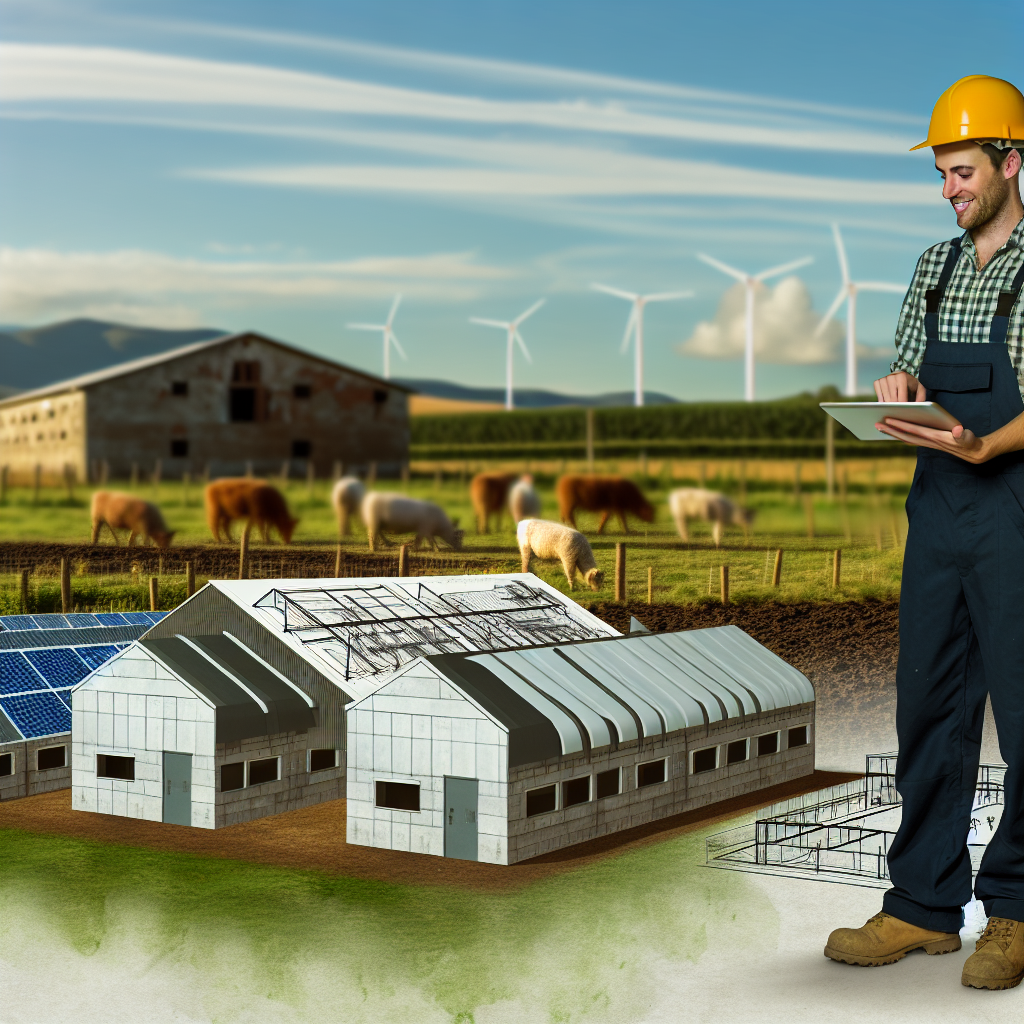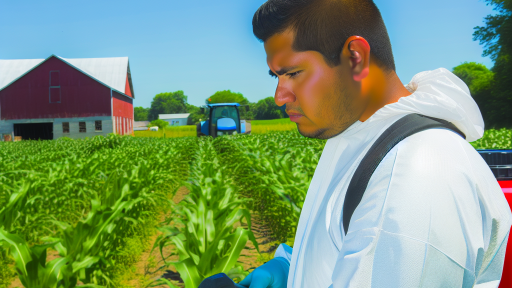Introduction to Sustainable Livestock Housing
Importance of Sustainable Livestock Housing
Sustainable livestock housing plays a crucial role in modern agriculture.
It provides safe environments for animals while reducing negative impacts on the ecosystem.
Additionally, it fosters animal welfare by promoting health and comfort.
Farmers benefit from sustainable practices through lower operational costs.
Moreover, these strategies often lead to improved product quality.
In this context, sustainable housing contributes significantly to food security.
Benefits of Sustainable Design
Investing in sustainable livestock housing offers various advantages.
First, it enhances resource efficiency, leading to reduced waste.
Second, these designs improve air and moisture management.
This leads to healthier living conditions for livestock.
Furthermore, sustainable designs can minimize energy consumption.
As a result, farms can operate more sustainably and economically.
Finally, well-designed housing can increase overall productivity.
In turn, this positively impacts both the animals and the farmers.
Long-Term Sustainability
Long-term sustainability is a key consideration in livestock housing design.
Transform Your Agribusiness
Unlock your farm's potential with expert advice tailored to your needs. Get actionable steps that drive real results.
Get StartedChoosing durable materials ensures longevity and reduces maintenance costs.
Incorporating renewable energy sources further enhances sustainability.
For instance, solar panels can provide energy for operations.
This shift not only lowers expenses but also supports environmental goals.
Overall, a sustainable approach leads to resilient farming practices.
Key Principles of Sustainable Livestock Housing Design
Optimizing Resource Efficiency
Efficient use of resources is vital for sustainable livestock housing.
This includes energy, water, and materials.
Implementing renewable energy sources can significantly reduce costs.
Solar panels and wind turbines are excellent options.
Furthermore, consider greywater recycling to conserve water.
Prioritizing Animal Welfare
Animal welfare must remain a primary focus in design.
Ensure adequate space for each animal to move comfortably.
Also, incorporate natural light and ventilation for a healthier environment.
These elements can improve animal health and productivity.
Enhancing Durability and Maintenance
Choose durable materials for livestock housing structures.
Materials like galvanized steel or treated wood last longer.
Additionally, easy maintenance can lower long-term costs.
Consider designs that allow for simple cleaning and repairs.
Integrating With the Environment
Design must complement the surrounding landscape.
Use local materials to reduce transportation emissions.
Moreover, creating natural habitats around the housing can support biodiversity.
Native plants can attract beneficial insects and pollinators.
Emphasizing Waste Management
Effective waste management is crucial for sustainability.
Implement systems for composting or anaerobic digestion.
Showcase Your Farming Business
Publish your professional farming services profile on our blog for a one-time fee of $200 and reach a dedicated audience of farmers and agribusiness owners.
Publish Your ProfileThese methods can convert waste into valuable resources.
Additionally, proper waste management reduces odors and pests.
Facilitating Community Engagement
Engage local communities in the planning process.
Gathering input can lead to more acceptable designs.
Moreover, including community members fosters support for the project.
This engagement can also promote education about sustainable practices.
Materials Selection for Eco-Friendly Livestock Housing
Importance of Material Choice
Choosing the right materials is crucial for sustainable livestock housing.
These materials impact both the environment and animal welfare.
Opting for eco-friendly options reduces the carbon footprint.
Wood as a Renewable Resource
Wood is a popular choice due to its renewability and insulation properties.
Use certified sustainably-sourced wood to ensure responsible harvesting.
Wood can also provide a natural aesthetic to the housing structure.
Recycled and Reclaimed Materials
Consider using recycled materials to minimize waste.
Reclaimed wood and metal can add character while being eco-friendly.
These materials help divert waste from landfills, supporting sustainable practices.
Low-Impact Concrete Alternatives
Innovative concrete alternatives can reduce environmental impact.
Look into hempcrete or other bio-based concretes for walls.
These options require less energy to produce compared to traditional concrete.
Insulation Materials
Proper insulation is essential for animal comfort and energy efficiency.
Choose natural insulation like straw bales or cellulose made from recycled paper.
These materials provide excellent thermal properties while being eco-friendly.
Water Management Considerations
Materials that support effective water management are vital.
Use permeable surfaces to allow water infiltration and prevent runoff.
This approach helps maintain a healthier environment for livestock.
Sustainable Coatings and Treatments
Opt for non-toxic paints and treatments to protect wood and surfaces.
These coatings should be free from harmful chemicals to avoid contamination.
Eco-friendly treatments can extend the lifespan of materials used in construction.
Guidance on Material Selection
Before finalizing any material choice, assess its life cycle.
Consider both the sourcing and manufacturing impacts on the environment.
Engage community resources and experts for informed decisions.
Regulatory Compliance and Best Practices
Ensure all material selections conform to local regulations and standards.
Staying compliant enhances sustainability and promotes safety.
Regularly update knowledge on best practices in sustainable construction.
You Might Also Like: Conserving Biodiversity in Agricultural Landscapes
Ventilation Strategies for Enhanced Livestock Welfare
Importance of Proper Ventilation
Proper ventilation significantly impacts livestock health and productivity.
It helps maintain optimal temperature and humidity levels.
Additionally, proper airflow reduces harmful gas concentrations.
Ventilation can prevent respiratory issues among livestock.
Healthy animals lead to improved growth rates and milk production.
Passive Ventilation Techniques
Passive ventilation utilizes natural airflow for climate control.
Showcase Your Farming Business
Publish your professional farming services profile on our blog for a one-time fee of $200 and reach a dedicated audience of farmers and agribusiness owners.
Publish Your ProfileThis method often involves designing buildings to enhance airflow.
Strategically placed windows and vents facilitate air exchange.
Sloped roofs can also promote natural ventilation due to stack effect.
Consider using windbreaks to redirect airflow within animal housing.
Mechanical Ventilation Systems
Mechanical ventilation uses fans to ensure consistent airflow.
This system provides better control over indoor climates.
Fans can help regulate temperature during extreme weather conditions.
Ensure that fans are appropriately sized for the space.
Regular maintenance is essential for optimal fan performance.
Combining Ventilation Strategies
Combining passive and mechanical strategies maximizes efficiency.
A hybrid system can balance energy use and animal comfort.
Use passive techniques to enhance mechanical systems support.
Evaluate seasonal needs to optimize ventilation methods.
This dual approach can lead to cost savings over time.
Monitoring and Maintenance
Regular monitoring is crucial for effective ventilation solutions.
Use sensors to track temperature and humidity levels effectively.
Perform routine checks on ventilation equipment.
Inspect ducts and fans for blockages or wear regularly.
Adjust systems based on environmental changes or livestock needs.
Uncover the Details: Creating Habitats to Support Farm Biodiversity
Waste Management Systems in Sustainable Housing Designs
Importance of Effective Waste Management
Effective waste management is crucial for sustainable livestock housing.
It minimizes environmental impacts associated with livestock operations.
Moreover, it promotes the health of animals and the surrounding ecosystem.
Types of Waste Generated
Livestock farming produces various types of waste.
Manure is the most common waste and has significant nutrient content.
Dead animals, bedding materials, and feed waste also contribute to waste volume.
Implementing Waste Management Systems
Installing an efficient waste management system is essential.
Consider composting as a primary approach for nutrient recycling.
Composting reduces waste volumes and produces organic fertilizer.
Additionally, anaerobic digestion provides energy while managing waste.
Choosing the Right Techniques
Select appropriate techniques based on the specific farm needs.
- Use pit storage for temporary manure management.
- Incorporate liquid waste management systems for efficient processing.
- Evaluate the potential for biogas production on-site.
Regular Maintenance and Monitoring
Regular maintenance ensures waste systems function effectively.
Conduct frequent inspections to identify potential problems.
Additionally, keep accurate records of waste produced and managed.
Social and Regulatory Considerations
Engaging with local communities can enhance waste solutions.
Stay informed about local regulations affecting waste management.
Compliance with regulations fosters good relationships with neighbors.
Benefits of Sustainable Waste Management
Implementing sustainable waste management yields multiple benefits.
- Improves farm resilience and profitability.
- Enhances soil health and productivity.
- Reduces greenhouse gas emissions.
Ultimately, these practices contribute to sustainable livestock operations.
Uncover the Details: Reducing Farm Waste with Green Technologies
Showcase Your Farming Business
Publish your professional farming services profile on our blog for a one-time fee of $200 and reach a dedicated audience of farmers and agribusiness owners.
Publish Your ProfileEnergy Efficiency Practices in Livestock Facilities
Optimizing Natural Light
Maximizing natural light reduces energy consumption for lighting.
Design facilities with large windows and skylights.
Use reflective surfaces to distribute light evenly.
Consider the building orientation to capture sunlight effectively.
Ventilation Strategies
Good ventilation is essential for animal health and comfort.
Install adjustable vents to regulate airflow as needed.
Use fans to enhance natural ventilation during hot days.
Ensure that exhaust systems remove excess heat and humidity.
Insulation Techniques
Proper insulation minimizes energy loss across seasons.
Use high-quality insulation materials in walls and roofs.
Seal gaps and cracks to prevent drafts and heat loss.
Consider insulated flooring to maintain temperature stability.
Energy-Efficient Lighting
Switching to LED lighting decreases energy usage significantly.
Implement motion sensors to activate lights only when needed.
Choose lighting solutions that provide adequate brightness for tasks.
Schedule regular maintenance to ensure optimal performance.
Utilizing Renewable Energy Sources
Solar panels can power livestock facilities sustainably.
Wind turbines offer another option for renewable energy.
Your farm layout should accommodate these energy systems effectively.
Consider government incentives for renewable energy installations.
Water Conservation Measures
Efficient water use also contributes to overall energy efficiency.
Implement rainwater harvesting systems for irrigation and washing.
Install low-flow water fixtures to reduce excess consumption.
Use water recycling systems to reuse water within the facility.
See Related Content: Implement Crop Rotation for Eco-Friendly Farming

Integration of Natural Elements in Livestock Housing
Importance of Natural Elements
Integrating natural elements enhances livestock welfare.
Natural features mimic their natural habitats.
This results in reduced stress for the animals.
Moreover, it promotes healthier growth and better productivity.
Incorporating Green Spaces
Green spaces provide essential outdoor access.
Creating pastures improves livestock movement and foraging behavior.
Additionally, trees can offer shade and reduce heat stress.
Plants also aid in dust control, improving overall air quality.
Use of Natural Materials
Employing natural materials in construction is beneficial.
Wood, clay, and straw create a pleasing environment.
These materials often provide better insulation.
As a result, buildings stay warmer in winter and cooler in summer.
Water Management Techniques
Effective water management supports animal health.
Utilizing natural water sources benefits the ecosystem.
Ponds can also serve as a habitat for local wildlife.
Showcase Your Farming Business
Publish your professional farming services profile on our blog for a one-time fee of $200 and reach a dedicated audience of farmers and agribusiness owners.
Publish Your ProfileRainwater harvesting systems reduce dependency on external water sources.
Enhancing Biodiversity
Diverse ecosystems support robust livestock systems.
Strategically planting native vegetation invites beneficial insects.
This aids pollination and pest management naturally.
Furthermore, leveraging biodiversity strengthens the farm’s resilience.
Innovative Technologies for Sustainable Livestock Housing
Introduction to Innovative Technologies
Innovative technologies enhance sustainable livestock housing significantly.
These advancements address the environmental impacts of traditional practices.
Renewable Energy Solutions
Integrating renewable energy sources is essential for sustainable designs.
Solar panels provide clean energy and reduce operational costs.
Wind turbines can also generate sustainable power for livestock operations.
Additionally, biogas systems convert animal waste into renewable energy.
Advanced Ventilation Systems
Efficient ventilation systems improve air quality in livestock housing.
Natural ventilation methods utilize design features to optimize airflow.
Mechanical ventilation systems can control temperature and humidity precisely.
These systems enhance animal welfare and reduce disease risks.
Smart Sensors and Automation
Smart sensors monitor environmental conditions in real-time.
Data collected helps farmers make informed management decisions.
Automated feeding systems improve feed efficiency and reduce waste.
These technologies also enhance animal monitoring and health management.
Waste Management Innovations
Innovative waste management technologies help minimize pollution.
Composting systems convert manure into valuable organic fertilizers.
Livestock housing designs should incorporate waste recycling measures.
Moreover, advanced treatment systems lower the environmental footprint.
Water Conservation Techniques
Water-saving technologies are crucial for sustainable livestock operations.
Rainwater harvesting systems collect and store water efficiently.
Drip irrigation promotes water-use efficiency in pasture management.
Implementing these practices conserves resources and reduces costs.
Case Studies of Successful Sustainable Livestock Housing Designs
Innovative Dairy Barns
One standout example is the Green Pastures Dairy Farm in Vermont.
This dairy employs a solar-powered ventilation system.
The design enhances airflow, reducing energy consumption.
Additionally, the barn uses recycled materials for construction.
This approach minimizes waste and lowers costs.
Consequently, animal welfare improves due to better living conditions.
Eco-Friendly Poultry Housing
Sunny Meadows Poultry Farm showcases an excellent sustainable design.
The facility incorporates natural light through skylights.
This feature reduces the need for artificial lighting.
Furthermore, it uses a rainwater harvesting system.
This system supplies fresh water for the birds.
Moreover, the farm utilizes deep litter systems to enhance soil health.
As a result, they produce organic compost for their crops.
Showcase Your Farming Business
Publish your professional farming services profile on our blog for a one-time fee of $200 and reach a dedicated audience of farmers and agribusiness owners.
Publish Your ProfileBeef Cattle Sustainable Systems
Highland Acres features a rotational grazing system.
This method promotes soil health and reduces overgrazing.
The farm also installs mobile shelters for cattle.
These shelters provide protection from extreme weather.
Farmers easily move them to promote pasture recovery.
Consequently, this system supports both livestock and pasture quality.
Small Farm Goat Housing
Meadowview Farm has embraced an innovative goat barn design.
The structure includes natural ventilation and sunlight exposure.
This design not only enhances animal comfort but also saves on energy.
Additionally, it features a waste management system.
This system aids in composting manure for future crop use.
In turn, they meet both livestock needs and sustainability goals.
Integrated Systems Approach
West Farm’s integrated approach stands out among sustainable designs.
The farm combines livestock housing with crop production.
This synergy maximizes resource efficiency and reduces waste.
For instance, manure from the animals fertilizes the crops.
Efficiency improves, and reliance on external inputs decreases.
Consequently, the farm creates a more resilient agricultural system.




